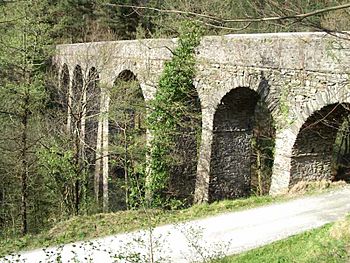Leitzaran facts for kids
Quick facts for kids Leitzaran |
|
|---|---|

Aqueduct over river Leitzaran in Ameraun
|
|
| Country | Spain |
| Physical characteristics | |
| Main source | Leitza about 600 m (2,000 ft) |
| River mouth | River Oria 92 m (302 ft) |
| Length | 42 km (26 mi) |
| Basin features | |
| Basin size | 124.02 km2 (47.88 sq mi) |
The Leitzaran (pronounced "lay-tsah-rahn") is a river and a beautiful valley located in Navarre and the Basque Country in Spain. This river flows into the larger Oria river from its right side.
The Leitzaran river starts its journey in the town of Leitza in Navarre. It is about 42 kilometres (26 mi) long. The river then enters the Gipuzkoa region at a place called Urto. Many towns like Areso, Berastegi, Elduain, Villabona, Urnieta, and Andoain are part of its water system. The total area that collects water for the Leitzaran is about 124.02 square kilometres (47.88 sq mi).
Contents
Exploring the Leitzaran Valley
The part of the river's basin in Gipuzkoa is known as the "Valle de Leizaran," which means "Leitzaran Valley." The name "Leitzaran" itself means "the valley of Leitza" in the Basque language. This valley is mostly shaped by an old mountain range called the "Macizo de Cinco Villas."
The rocks in this area were formed a very long time ago, during the Paleozoic Era, specifically in the Carboniferous period. These rocks are mainly slate and sandstone. The Leitzaran river is quite winding, with many bends and curves called meanders.
The Leitzaran valley in Gipuzkoa is bordered on the east by the valley of the Urumea river. These two valleys are separated by the Adarra-Mandoegi mountain chain. On the west, the valley is separated from other areas by the Uzturre-Ipuliño mountain chain.
A Protected Natural Area
The banks of the Leitzaran river and its smaller rivers, Ubaran (Ubane) and Malo, were declared Protected Biotopes on September 29, 1995. A biotope is a natural area with a specific environment and living things. These protected areas cover about 0.74 square kilometres (0.29 sq mi).
Even though the area looks wild and untouched, people have lived and worked here for a very long time. You can find many ancient monuments from prehistoric times, especially along its edges. People have also grazed animals here for centuries, as shown by old grazing areas called "seles."
River's Role in Industry
The Leitzaran river has been very important for local industries throughout history. One of the most significant industries was the blast furnaces, which used the river's power. These furnaces processed minerals found in the valley itself, and sometimes minerals were brought in from other places like Somorrostro.
The river's water has also powered many flour watermills. These mills used the river's flow to grind grain into flour. Additionally, the river has been used to create electricity through small hydroelectric power stations. Some of these stations are still working today!
The Bizkotx Mines and Old Railway
To transport minerals from the Bizkotx mines, a railway was built. These mines were located near a place called Plazaola. The railway line went from the mines all the way to Andoain. Later, the railway was extended in both directions. It reached Pamplona on one end and Lasarte on the other. In Lasarte, it connected with the Ferrocarriles Vascongados (Basque Railways), which allowed it to provide services to Donostia (San Sebastián).
This railway, which ran between Pamplona and San Sebastián, was very popular. People often called it "Tren del Plazaola" (Plazaola's Train) in Spanish or "Tren-txiki" (Little Train) in Basque.
The Plazaola Greenway
Today, a large part of the old Plazaola railway line is being turned into a greenway. A greenway is a path or trail designed for walking, cycling, and other outdoor activities. It's a great way for people to enjoy nature and the history of the area.
See also
- List of rivers of Spain
- For more information in Spanish, visit: Leizarán para niños

